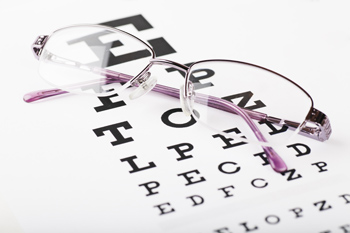Our DMV-approved online drivers education course is designed just for teens. Study at your own pace, pass the final test, and get your certificate.
Sign Up Now – Only $19.90 Learn More About Teen Drivers EdVision is the process of eyes and brain working together to perceive depth and identify the size, shape, color, texture, distance and motion of the objects. Because this process is complex and delicate, there is a likelihood of things not lining up correctly and creating imperfect or poor vision.
When it comes to driving, it is important to have good vision and the ability to clearly see everything on the road and make the right decision for every situation based on good vision.

Visual Acuity, Eye Chart, and 20/20 Vision.
When doctors provide an eye exam, they may use a standard eye chart called the “Snellen Eye Chart.” This chart uses 11 rows of capital letters. The top row has the largest letter and the letters become progressively smaller as you go down the rows.
During the eye exam, it is more likely that your doctor will put an eye chart behind you and use a mirror to stimulate the 20-foot distance and ask you to read the smallest letters in the row. If you can read the very bottom row, your eyesight is very good.
Visual acuity is the measurement of the clarity or sharpness of the vision. 20/20 vision (or 20/20 visual acuity) is considered normal (good) vision. A person with 20/20 visual acuity can clearly see and read any letter 20 feet away, the same way a person with a normal vision can clearly see and read the same letters from 20 feet away.
If you can only read the top letter (largest letter) from 20 feet; this means that your vision is 20/200 because a person with a normal vision can read the top letter from 200 feet without any problems.
A few other examples:
When you apply for your license, the DMV will check your vision. You must have at least 20/40 vision with both eyes. If you cannot see at this level without glasses or contacts, you are legally required to wear glasses or contact lenses every time you drive.
Field of View.
Field of View (also known as Field of Vision) is the maximum area that is visible by our eyes at any given time. Humans have about 180-degree forward and horizontal fields of view.
Central and Peripheral Vision.
This may have come to you naturally; you use your eyes to see what is ahead of you, but at the same time, you are conscious of your surroundings (sides) and can detect any motions or objects to your sides.
When you look directly ahead of you, you use your Central Vision. You also use your Central Vision to see your front field of view and see objects in more detail.
When you are looking ahead, but can see objects or motions to your sides, you use your Peripheral Vision to see the objects to your sides. Your Peripheral Vision covers all other fields of view outside the central vision field of view. Peripheral Vision does not provide a detailed view but is best for detecting motion.
Peripheral Vision is very helpful when driving. For example, while you use your Central Vision to see ahead of you, you may notice the motion of a pedestrian approaching from the side. In this situation, you will react by quickly turning your head to see the pedestrian using your Central Vision and stop to avoid hitting the pedestrian.
Depth Perception.
The depth perception is your ability to determine the distances between objects as it relates to your position. Depth perception helps you see the world in three dimensions.
Depth perception is used at many aspect of driving such as managing your space between your car and other cars, merging onto freeways, passing other vehicles or allowing space for other vehicles to maneuver around your vehicle.
Poor depth perception can cause deterioration in driving such as during the following:
Night Vision.
Night Vision is your ability to see clearly in low-light situations or at night. Night driving requires you to see low-contrast objects well.
People with poor night vision may not have the ability to see low-contrast objects well, so if there is a pedestrian in dark clothing crossing the street, a person with poor night vision may not see the pedestrian. People with poor night vision may also not have the ability to see and react to dark hazards at night.
Color Blindness.
People who are colorblind may not have the ability to differentiate between different colors. A colorblind driver may not be able to distinguish the color of traffic lights, signs, or curbs.
If you are colorblind, you should use the shapes, patterns, and positions of signs and signals to understand their meaning.